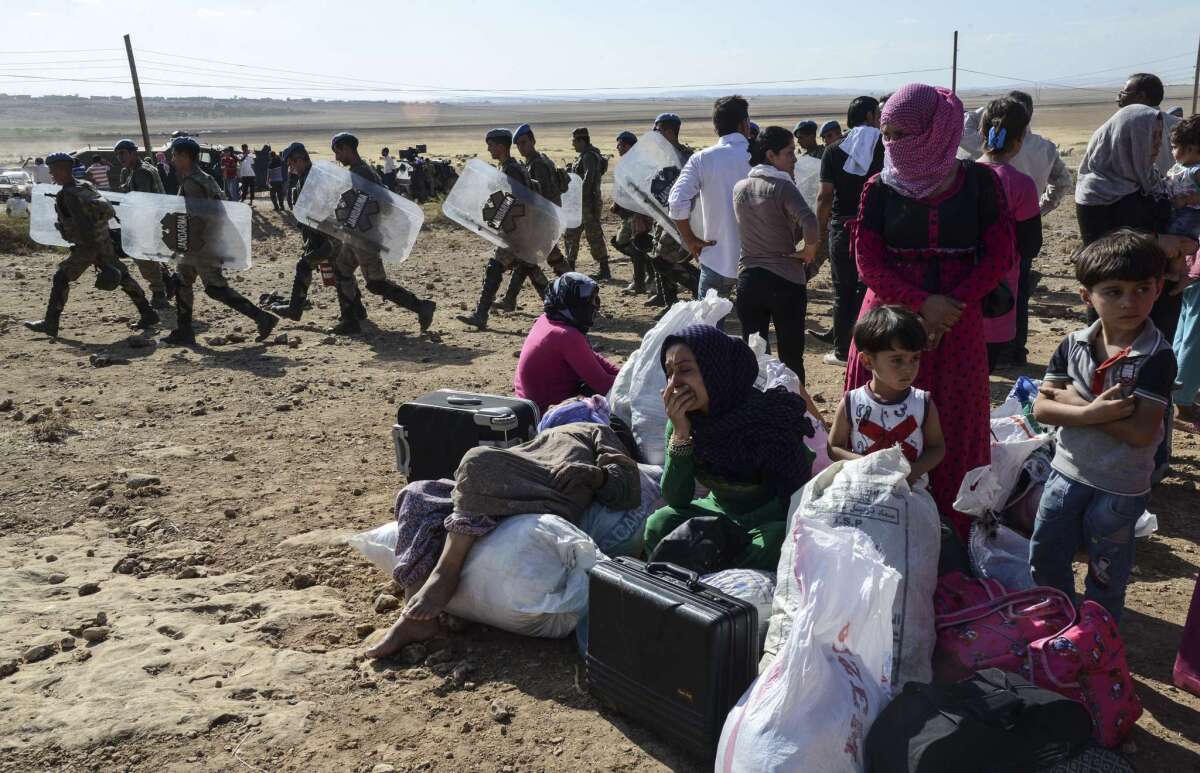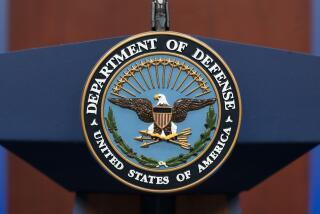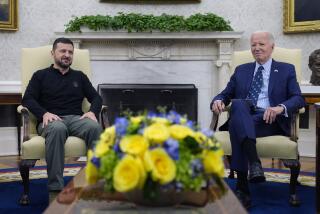Pentagon ramps up airstrikes in Syria to help U.S.-backed rebels

Reporting from Beirut — U.S. officials Monday confirmed an expanded bombing campaign in Syria that increases the risk of confrontation with forces loyal to Syrian President Bashar Assad, possibly drawing Washington more deeply into that country’s punishing four-year war.
The Obama administration authorized the Pentagon to use force to help defend a small, U.S.-trained Syrian rebel unit against other insurgent factions — or against fighters allied with the Syrian government, officials said.
U.S. warplanes already struck last week, bombarding Al Qaeda-linked Syrian rebels who had attacked the Pentagon-backed force.
Until now, the U.S.-led air campaign that began last August has focused almost exclusively on Islamic State, the breakaway Al Qaeda faction that controls huge parts of Syria and neighboring Iraq. President Obama has called on Assad to step down, but the U.S. military has refrained from targeting pro-Assad forces.
U.S. officials emphasized that the expanded mission was defensive in nature and did not signal an offensive push against Assad’s military, which is also fighting Islamic State. The Pentagon downplayed the possibility of a confrontation with Assad’s forces, though the Syrian air force is active in northern Aleppo province, where the U.S.-backed forces are operating.
“We are not at war with the Assad regime,” said Capt. Jeff Davis, a Pentagon spokesman. “This is not something we view as inviting confrontation with Assad in any way.”
There was no official comment from Damascus. But wary Syrian officials have long viewed the U.S. bombing campaign against Islamic State in Syria as a possible precursor for bombardment of pro-government forces.
The move also raises the possibility that Assad’s military may be forced to pull back its air power to avoid confrontation with U.S. forces, thus neutralizing Damascus’ major strategic advantage against myriad opposition groups, including Islamic State.
The policy shift came to light after the first group of several dozen U.S.-vetted and trained fighters in northern Syria was attacked Friday by Al Nusra Front, the official Al Qaeda affiliate in Syria. U.S. warplanes soon swept in to help defend the Pentagon-trained unit, marking the first time that American aircraft had directly supported the trainees.
Additional airstrikes are likely, officials said, as the U.S.-trained unit seeks ways to confront Islamic State, which Obama has vowed to destroy.
“We won’t get into the specifics of our rules of engagement, but have said all along that we would take the steps necessary to ensure that these forces could successfully carry out their mission,” said Cmdr. Elissa Smith, a Pentagon spokeswoman. “We demonstrated our resolve in this respect on Friday.”
The newly trained Syrian force was “being provided with a wide range” of support, said White House National Security Council spokesman Alistair Baskey. He called the airstrikes another measure “to protect them.”
The Al Nusra Front attack represents the latest setback for the Pentagon’s faltering effort to field what it calls a “moderate” force amid a disparate Syrian rebel movement now dominated by hard-core Islamists.
The Obama administration’s $500-million initiative to train and arm an opposition force in Syria has been beset by problems and delays and thus far has produced fewer than 60 fighters.
In several statements, Al Nusra Front denounced the new U.S.-trained force as Western “agents” and vowed to “cut the hand … of the Americans.” The attack on the U.S.-trained force occurred in the strategic town of Azaz, close to the Turkish border, according to various reports.
The area is part of a new, U.S.-Turkish plan for a “safe zone” in northwestern Syria that would use U.S. airstrikes and Western-backed rebels to expel Islamic State from a strip of contested territory south of Turkey’s border with Syria. But Al Nusra Front and other hard-line Islamic groups have a major presence in the proposed safe zone.
Al Nusra Front also said it had captured several members of a Western-backed rebel faction known as Division 30 in attacks last week. But U.S. officials denied that any members of the Pentagon-trained unit had been taken prisoner.
It is not the first time that Al Nusra Front has turned its guns on U.S.-backed rebel factions in northwestern Syria. Al Nusra Front fighters have previously routed a pair of high-profile Western-backed proxy fighting forces, the Harakat Hazm movement and the Syria Revolutionaries Front. Al Nusra Front said it had captured U.S.-provided weapons, including sophisticated TOW antitank missiles, in its attacks on Harakat Hazm.
In Moscow, a staunch ally of Assad, Russian officials warned Monday that the U.S. decision to back allied Syrian rebels with airstrikes threatens to unleash wider chaos in Syria and set back the fight against Islamic State.
Russia has “repeatedly underlined that help to the Syrian opposition, moreover financial and technical assistance, leads to further destabilization of the situation in the country,” Kremlin spokesman Dmitry Peskov told reporters.
The expanded U.S. bombing mission comes as an independent monitoring group, Airwars.org, released the results of a six-month investigation that found U.S.-led coalition aircraft have probably killed at least 459 civilians in Syria and Iraq since the air war began last August. The Pentagon has confirmed only two civilian deaths, both children, from more than 5,600 coalition airstrikes.
The U.S. military reviews all allegations of civilian casualties to determine whether the charges are credible, said Sgt. 1st Class Sheryl L. Lawry, U.S. Central Command spokeswoman.
The military has six active investigations open, including four in Iraq and two in Syria. Four other investigations have been completed, including the one involving the two children.
“We apply very rigorous standards in our targeting process to avoid or to minimize civilian casualties in the first place,” Lawry said. “We take great care — from analysis of available intelligence to selection of the appropriate weapon to meet mission requirements — in order to minimize the risk of collateral damage, particularly any potential harm to noncombatants.”
Although U.S. airstrikes have almost exclusively focused on Islamic State, a number of attacks in northern Syria have also hit Al Nusra Front-affiliated operatives whom the Pentagon collectively calls the Khorasan Group. The Pentagon describes the group as seasoned Al Qaeda terrorists who have been plotting attacks against the West from parts of Syria held by rebels.
Under the new Syrian rebel training program announced in June 2014, the Pentagon initially envisioned 5,400 graduates within a year.
The four countries where the training takes place — Turkey, Jordan, Saudi Arabia and Qatar — sharply disagree with Washington on what the proxy force should do. Leaders of those nations want the newly trained troops to focus first on ousting Assad; the White House wants the fighters to target Islamic State.
McDonnell reported from Beirut and Hennigan from Washington. Times staff writer Carol J. Williams in Los Angeles and special correspondent Nabih Bulos in Amman, Jordan, contributed to this report.
Follow @wjhenn for military and defense info.
ALSO:
Keep on fighting, new Taliban leader says
In the heart of Kabul, the eyes are watching
Palestinian toddler burned to death in attack by suspected Israeli extremists
More to Read
Sign up for Essential California
The most important California stories and recommendations in your inbox every morning.
You may occasionally receive promotional content from the Los Angeles Times.











